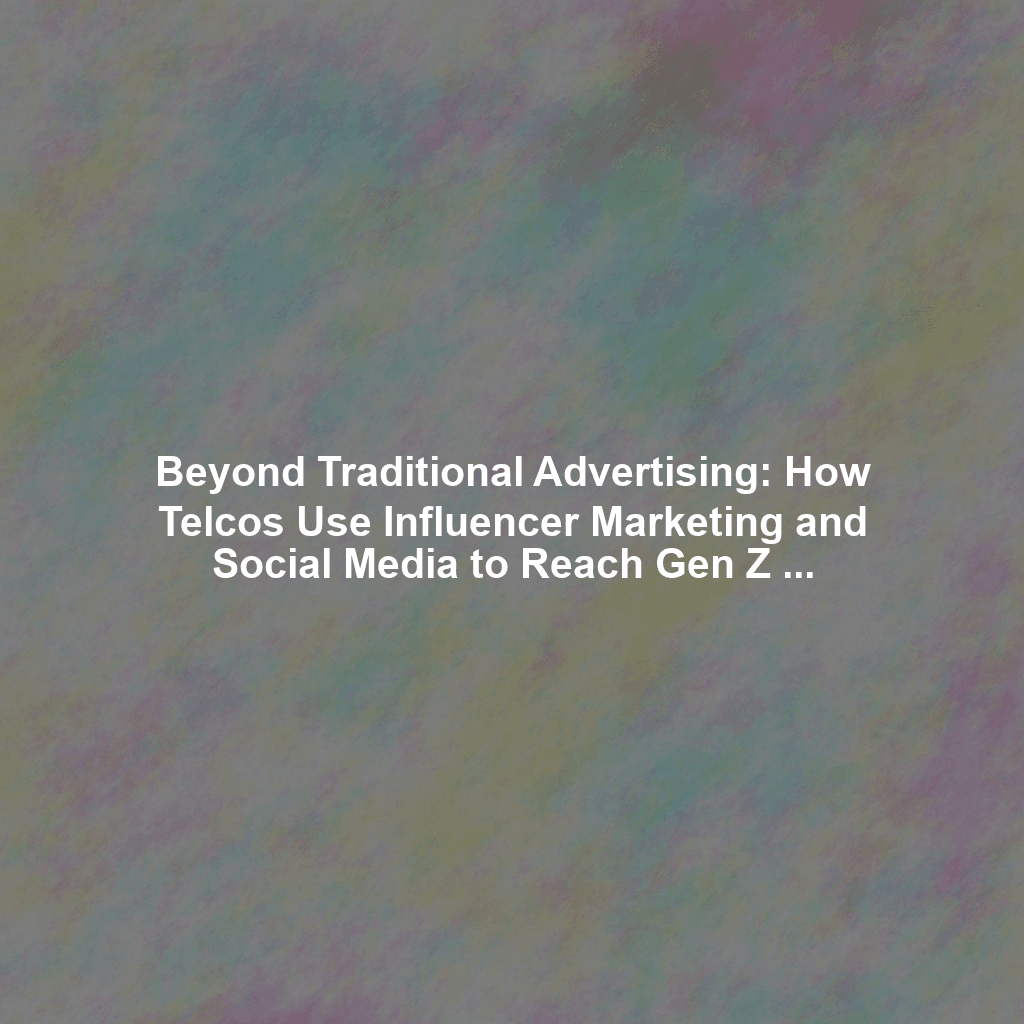The Shift to Influencer Marketing
The telecom industry is fiercely competitive. Differentiating their services and appealing to younger audiences requires more than just highlighting technical specifications. Influencer marketing allows these companies to connect with potential customers on a more personal and authentic level. By partnering with trusted voices within specific communities, telcos can build brand awareness, drive product adoption, and ultimately, boost their bottom line.
Why Influencer Marketing Works for Telcos
- Authenticity: Influencers provide a more relatable and genuine perspective than traditional advertising.
- Targeted Reach: Telcos can select influencers who cater to specific interests and demographics within Gen Z and Millennials.
- Increased Engagement: Influencer content often generates higher engagement rates than traditional ads.
- Brand Credibility: Association with a trusted influencer can enhance brand credibility and trustworthiness.
Successful Influencer Campaigns by Major Telcos
Let’s examine some examples of how Verizon, T-Mobile, and AT&T have successfully leveraged influencer marketing:
Verizon: Focusing on Reliability and Community
Verizon often partners with influencers who emphasize the reliability and speed of their network, particularly in areas with strong community ties. They might work with local travel bloggers to showcase how Verizon’s connectivity enhances travel experiences or partner with gaming streamers to highlight the low latency of their 5G network for online gaming.
One example would be collaborating with a group of outdoor adventurers, showcasing the reliability of the Verizon network in remote locations, sharing their experiences and highlighting how they stayed connected to their audience and emergency services, thanks to Verizon.
T-Mobile: The Un-Carrier Approach with Bold Personalities
T-Mobile’s “Un-carrier” brand identity is reflected in their influencer choices. They often collaborate with bold, outspoken personalities who align with their disruptive and innovative image. They frequently use influencers to promote new plans, features, and initiatives, often emphasizing value and customer-centric benefits.
They might also partner with creators who champion social causes or promote inclusivity, aligning with their brand values and resonating with socially conscious Gen Z and Millennials.
AT&T: Emphasizing Entertainment and Innovation
AT&T, with its focus on entertainment and innovation, frequently partners with influencers in the tech, gaming, and entertainment spaces. They might sponsor live streams, collaborate on video content, or host events featuring popular creators to promote their bundled services and cutting-edge technologies.
AT&T uses targeted youtube ads to drive specific traffic to influencers that help them highlight the latest features of their services.
Influencer Selection Criteria
Choosing the right influencer is crucial for the success of any campaign. Telcos consider several factors when selecting their partners:
Relevance and Audience Demographics
Does the influencer’s content align with the telco’s brand and target audience? Do their followers match the desired demographic profile (age, location, interests, etc.)?
Engagement Rate and Authenticity
Does the influencer have a high engagement rate (likes, comments, shares)? Are their interactions with followers genuine and authentic?
Brand Alignment and Values
Does the influencer’s personal brand align with the telco’s values and messaging? Are they known for integrity and credibility?
Content Quality and Consistency
Is the influencer’s content high-quality, engaging, and consistent with their overall brand? Do they maintain a professional and reliable online presence?
Social Media Platforms: TikTok, Instagram, and YouTube
Telcos utilize a variety of social media platforms to reach Gen Z and Millennials, each with its own unique strengths:
TikTok: Short-Form Video for Viral Content
TikTok’s short-form video format is ideal for creating viral content that quickly grabs attention. Telcos use TikTok to launch challenges, promote new products, and engage with users through humor and creativity.
Instagram: Visual Storytelling and Influencer Marketing
Instagram’s visual focus makes it a powerful platform for influencer marketing. Telcos partner with influencers to create visually appealing content that showcases their products and services in a lifestyle context.
YouTube: Long-Form Content and Tutorials
YouTube is ideal for longer-form content, such as product reviews, tutorials, and behind-the-scenes glimpses into the telco’s operations. Telcos use YouTube to provide valuable information and build brand awareness over time.
ROI and Challenges of Influencer Marketing in the Telecom Industry
While influencer marketing offers significant potential, it also presents challenges:
Measuring ROI
Attributing direct sales to influencer campaigns can be difficult. Telcos often rely on metrics such as brand awareness, website traffic, and lead generation to measure ROI.
Maintaining Authenticity
Ensuring that influencer content remains authentic and credible is crucial. Overly promotional or inauthentic content can damage brand reputation.
Compliance and Transparency
Telcos must adhere to advertising regulations and ensure transparency in their influencer marketing campaigns, disclosing sponsored content clearly.
Managing Influencer Relationships
Building and maintaining strong relationships with influencers requires time and resources. Effective communication and clear expectations are essential.
Conclusion
Influencer marketing and strategic social media campaigns have become vital components of the modern telecom marketing mix. Verizon, T-Mobile, and AT&T are actively leveraging the power of online personalities to connect with Gen Z and Millennials, building brand awareness, and driving product adoption. While challenges exist, the potential ROI is significant, making influencer marketing a crucial strategy for telcos seeking to thrive in a rapidly evolving digital landscape. The key to success lies in selecting the right influencers, crafting authentic content, and measuring results effectively.
 Skip to content
Skip to content

